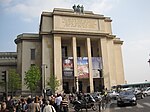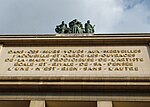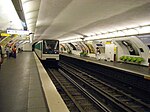Trocadéro Palace

The Trocadéro Palace was an eclectic building of Moorish and neo-Byzantine inspiration dating from the second half of the 19th century. Located in the 16th arrondissement of Paris, on the Chaillot hill between the Place du Trocadéro and the gardens of the same name, it comprised a 4,600-seat auditorium extended on either side by two curved wings, each housing a museum (the Musée des Monuments Français and the Musée d'Ethnographie), as well as conference rooms. Built for the 1878 Exposition Universelle, it was not intended to outlast the event; although the building was eventually preserved for some sixty years, it was widely criticized for its architectural style, its progressive dilapidation, and the poor acoustics of its main hall, which was soon deserted by orchestras. It was dismantled in 1935 in preparation for the 1937 Exposition Universelle, to make way for a new building, the Palais de Chaillot.
Excerpt from the Wikipedia article Trocadéro Palace (License: CC BY-SA 3.0, Authors, Images).Trocadéro Palace
Parvise of Freedom and Human Rights, Paris 16th Arrondissement (Paris)
Geographical coordinates (GPS) Address Nearby Places Show on map
Geographical coordinates (GPS)
| Latitude | Longitude |
|---|---|
| N 48.862222222222 ° | E 2.2883333333333 ° |
Address
Parvis des Libertés et des Droits de l'Homme
Parvise of Freedom and Human Rights
75016 Paris, 16th Arrondissement (Paris)
Ile-de-France, France
Open on Google Maps









